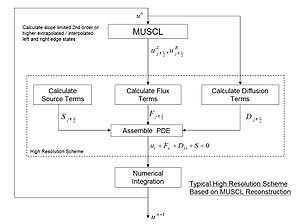
High resolution scheme
Encyclopedia

- Second or higher order spatial accuracy is obtained in smooth parts of the solution.
- Solutions are free from spurious oscillations or wiggles.
- High accuracy is obtained around shocks and discontinuities.
- The number of mesh points containing the wave is small compared with a first-order scheme with similar accuracy.
High-resolution schemes often use flux/slope limiter
Flux limiter
Flux limiters are used in high resolution schemes – numerical schemes used to solve problems in science and engineering, particularly fluid dynamics, described by partial differential equations...
s to limit the gradient around shocks or discontinuities. A particularly successful high-resolution scheme is the MUSCL scheme
MUSCL scheme
In the study of partial differential equations, the MUSCL scheme is a finite volume method that can provide highly accurate numerical solutions for a given system, even in cases where the solutions exhibit shocks, discontinuities, or large gradients...
which uses state extrapolation and limiters to achieve good accuracy – see diagram below.
See also
- Godunov's theoremGodunov's theoremIn numerical analysis and computational fluid dynamics, Godunov's theorem — also known as Godunov's order barrier theorem — is a mathematical theorem important in the development of the theory of high resolution schemes for the numerical solution of partial differential equations.The theorem states...
- Sergei K. GodunovSergei K. GodunovSergei Konstantinovich Godunov is professor at the Sobolev Institute of Mathematics of the Russian Academy of Sciences in Novosibirsk, Russia....
- Total variation diminishingTotal variation diminishingIn numerical methods, total variation diminishing is a property of certain discretization schemes used to solve hyperbolic partial differential equations...
- Shock capturing methodsShock capturing methodsIn computational fluid dynamics, shock-capturing methods are a class of techniques for computing inviscid flows with shock waves. Computation of flow through shock waves is an extremely difficult task because such flows result in sharp, discontinuous changes in flow variables pressure, temperature,...
Further reading
- Harten, A. (1983), High Resolution Schemes for Hyperbolic Conservation Laws. J. Comput. Phys., 49:357–293.
- Hirsch, C. (1990), Numerical Computation of Internal and External Flows, vol 2, Wiley.
- Laney, Culbert B. (1998), Computational Gas Dynamics, Cambridge University Press.
- Toro, E. F. (1999), Riemann Solvers and Numerical Methods for Fluid Dynamics, Springer-Verlag.

